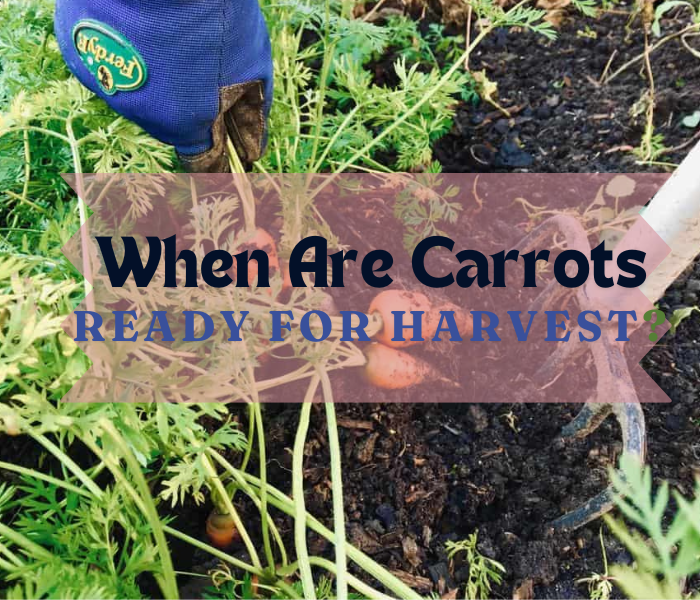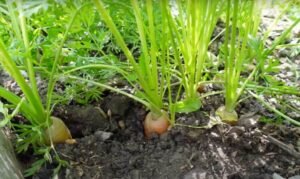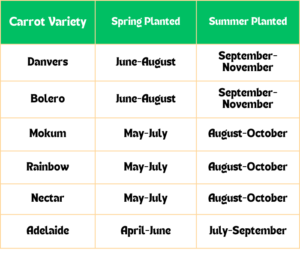
Carrots have quickly become one of the most beloved vegetables for good reason and for good harvest time too. Delectable carrots filled with essential vitamins are delicious treats and packed full of nutrients. They make for easy picking all year round, providing one with ample opportunity for harvest. However, to have optimal carrot harvest time results. The trick to harvesting delicious carrots lies in knowing when are carrots ready for harvest.
Carrots can be harvested when their shoulders begin to pop out from under the soil and look about the size of a quarter coin. For optimal summer harvest results, seeds should be planted no later than early spring; while for optimal autumn harvest results, they must be planted by mid-August.
When Are Carrots Ready For Harvest?

Carrots make wonderful year-round crops. With succession planting from spring until early fall, harvest will continue throughout the year! Keep this in mind if planting in the fall, any carrot you plant must be overwintered and harvested when spring rolls around again.
Seeds generally take two to three weeks to germinate in cool spring or fall environments. Once seedlings reach around an inch or two tall, you should thin them so you don’t end up with too many carrots competing for space as they grow.
Carrots typically reach full maturity within 60 to 75 days of planting depending on their variety, though it could happen sooner.
Below I have listed several popular carrot varieties and when they should be harvested.

Note that the answer to when are carrots ready for harvest is that carrots should be planted no later than 12 weeks prior to their expected first frost date in order for them to mature properly and harvest later, or overwinter them to harvest any time between winter and early spring.
Visual Signs that Carrots Are Ready for Harvest
Carrots can often deceive us by having large green leaves which give the illusion that its underground source must also be large; but, once pulled up you find that its actual root mass is quite tiny!
An effective way of telling when harvest time has arrived is to examine your carrot’s shoulders. Once large enough, these top portions may begin poking out of the soil when ready. Carrot shoulders should measure roughly an inch across, roughly equivalent to quarter size. As always, however, their exact measurements will depend on which variety is being grown.
As sometimes the shoulders aren’t visible, I find the easiest way to check that my carrots are growing at their proper sizes is simply digging one or two up that way, I know exactly how my crop is doing!
If you planted carrots in the fall and over-wintered them, by spring they may appear as though their greens have died back no need for alarm. The colder winter weather won’t harm their roots beneath!
Baby Carrots
For an easier harvest experience, harvest carrots before they have reached full size to have your very own baby carrots! And there are certain varieties, like Little Finger, Adelaide or Shin Kuroda that typically don’t grow beyond 5 inches; making these true baby carrot varieties.
Baby carrots offer just as much sweetness and nutrition as larger varieties, making them the ideal solution if space in your garden or container gardening is limited.
Carrot Leaves
Carrot leaves are highly delicious and completely edible! My preferred way of enjoying them is making carrot top pesto from them!
Be careful that you do not harvest greens before your carrots are mature for harvest; doing so could hinder their development as all their energy goes back into producing more greens than carrots.
My experience shows that harvesting carrot greens as I gather them works out nicely for me; but, if you still desire harvesting any, try harvesting several carrots at the same time so none are completely without greens.
How To Harvest Carrots?
Another important question besides when are carrots ready for harvest is how to harvest carrots. There’s more work involved with harvesting carrots than most people realize; most of us (myself included) want to just pull the carrots from the soil with our hands; unfortunately, this often ends in us pulling off all their greenery as well as leaving most of your precious harvest still sitting beneath the ground. To effectively harvest your crop you have several methods at your disposal that you should employ when picking.
Harvesting carrots takes more work than people expect. Most of us (myself included) just want to pluck out all our carrots by hand but often ends up pulling off greenery as we pull and leaves your precious root vegetables behind in the ground! To successfully harvest your crop this fall and winter.
What to Do with Bolted Carrots?
Carrots are biennial plants, meaning it takes two years for them to complete their full cycle and reach maturity. Because carrots take so long for growth to complete their cycle and blooming to occur before being harvested is rare.
But in case your carrots do flower, here’s what to do with them:
Saving Seeds
Seed saving can be a fantastic way to save money and ensure a seed supply for next season. Carrots flower, sending up tall stalks that bear white blooms containing seeds that you can save by collecting from their blossoming.
Eating bolted carrots
While there’s technically nothing wrong with eating carrots that have bolted, you may find they don’t taste quite right. They might become woody and tough with many sugars having left them leaving an artificial sweetness behind that might leave an aftertaste that you may find unpleasant.
But that doesn’t mean your plants are beyond redemption; both greens and flowers remain entirely edible; just be sure to taste test for any bitterness that might develop over time.
Carrot flowers are delicious treats that can easily fit into any meal. They can even be mixed into salads! Contrary to what may have been reported elsewhere, carrot flowers are not poisonous!
Learn more about: Can Potato Plants Get Too Tall? Why They May Fall Over
Final Words!
When are carrots ready for harvest? Don’t let harvesting carrots overwhelm you; as long as you know what to look for, harvesting will go smoothly. Keep an eye out on their shoulders to be sure that they have reached an appropriate size; dig one up every now and again just to double check on progress!
Growing carrots requires patience; although it takes several months for full maturity to arrive. They’re well worth waiting for!
